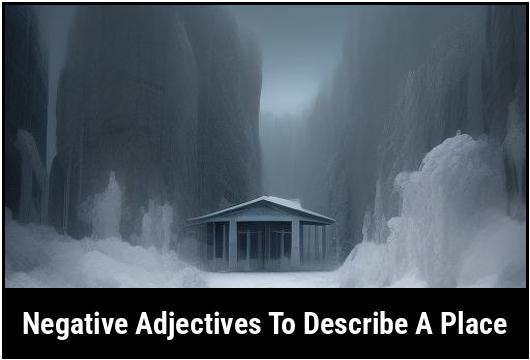- You are here:
- Home »
- adjectives
- » 31 Negative Adjectives To Describe A Place

31 Negative Adjectives To Describe A Place
When it comes to describing a place, adjectives play a crucial role in painting a vivid picture in the reader’s or listener’s mind. However, not all adjectives used to describe a place are positive. In fact, some adjectives paint a rather unflattering or negative picture of a place. This article delves into the world of negative adjectives used to describe a place, providing an in-depth exploration of their impact and usage.
Key Takeaways
- Negative adjectives used to describe a place can evoke powerful emotions and opinions.
- Selecting the right negative adjectives can effectively convey a nuanced and detailed depiction of a place.
- Negative adjectives may be used to caution or dissuade individuals from visiting or interacting with a particular place.
Negative Adjectives To Describe A Place
1. Dreary
A dreary place lacks liveliness and enthusiasm, often characterized by dullness and monotony. Whether it’s due to the weather, lack of activities, or a general sense of indifference, a dreary place can leave one feeling uninspired.
2. Crowded
A crowded place is overflowing with people, causing discomfort and a sense of intrusion. While bustling destinations can be energetic and vibrant, an excessively crowded place can tip the balance, making it difficult to fully enjoy the surroundings.
3. Isolated
An isolated place is cut off from the outside world, lacking connectivity and opportunities for interaction. It can cause feelings of loneliness or restriction, especially when access to essential amenities or socialization is limited.
4. Polluted
When a location is polluted, it means that the environment is contaminated and compromised, often due to factors like industrial waste, air pollution, or noise pollution. This can negatively impact the quality of life and overall health of the residents.
5. Uninviting
An uninviting place fails to attract or welcome visitors. Whether it’s because of a lack of aesthetic appeal, unfriendly locals or inhospitable infrastructure, an uninviting place might struggle to entice people to explore its offerings.
6. Desolate
A desolate place feels barren, abandoned, and devoid of life. It can be characterized by vast empty spaces, neglected buildings, or a general sense of abandonment, which can evoke feelings of melancholy or sadness.
7. Congested
A congested place is heavily congested with traffic, making it difficult to navigate or move freely. This can lead to frustration, delays, and even safety concerns, which can detract from the overall experience of being in that place.
8. Run-down
A run-down place shows signs of neglect or disrepair. Dilapidated buildings, crumbling infrastructure, or unkempt surroundings contribute to a sense of decay, which can diminish the appeal and safety of the location.
9. Repulsive
A repulsive place evokes strong feelings of disgust or aversion. It might be associated with unpleasant odors, sights, or unsanitary conditions that make it challenging to appreciate and enjoy being in that place.
10. Hostile
A hostile place is inhospitable, unwelcoming, or even dangerous due to factors such as high crime rates or political instability. This feeling of hostility can make individuals feel unwelcome or uneasy, hindering their ability to explore or engage with their surroundings.
11. Unsanitary
An unsanitary place lacks cleanliness and hygiene, posing potential health risks for those who inhabit it. Whether it’s due to garbage accumulation, inadequate sewage systems, or unsanitary food handling practices, these conditions can make individuals uncomfortable and potentially ill.
12. Ugly
An ugly place is aesthetically unappealing, lacking charm or visual appeal. The architecture, landscape, or general design elements may be perceived as unpleasant or unattractive, robbing the place of its potential for beauty.
13. Expensive
An expensive place is characterized by high costs of living, inflated prices for goods and services, or exorbitant tourist attractions. This can limit accessibility and discourage individuals from exploring or settling in such areas.
14. Noisy
A noisy place is filled with unwanted or excessive sounds, which can disturb peace and tranquility. Whether it’s due to constant traffic, construction work, or loud entertainment venues, noise pollution can be disruptive and negatively impact the overall experience within a location.
15. Unpleasant
An unpleasant place fails to provide a pleasant or enjoyable atmosphere. It might be due to factors such as unfriendly locals, uninspiring attractions, or a general lack of positive ambiance, leaving visitors with negative experiences and memories.
16. Dangerous
A dangerous place poses risks to personal safety and well-being. Whether it’s due to high crime rates, natural disasters, or other hazards, the feeling of constant threat can hinder individuals from feeling secure or at ease in that location.
17. Chaotic
A chaotic place lacks order, structure, or organization. It can be overwhelming and disorienting, making it difficult for individuals to navigate or comprehend their surroundings. The absence of clarity and predictability can be discouraging for visitors.
18. Unlivable
An unlivable place lacks the necessary standards of living or basic amenities required for a comfortable lifestyle. This could include factors such as limited access to clean water, electricity, or healthcare facilities, making it unsuitable for long-term habitation.
19. Boring
A boring place lacks excitement or interesting points of attraction. It fails to engage and captivate visitors, leaving them with a sense of unfulfilled expectations and a desire for more stimulating experiences.
20. Dirty
A dirty place is marked by a lack of cleanliness and hygiene. Whether it’s due to littering, inadequate waste management systems, or unsanitary public areas, filth can create an unfavorable atmosphere and detract from the overall enjoyment of a location.
21. Unwelcoming
An unwelcoming place fails to make visitors feel comfortable or accepted. This sentiment might be due to unfriendly locals, discriminatory attitudes, or a general lack of inclusivity, making individuals feel like outsiders in that location.
22. Depressing
A depressing place generates feelings of sadness, hopelessness, or dejection. The atmosphere, local culture, or environmental conditions might contribute to this sentiment, making individuals feel weighed down by their surroundings.
23. Stagnant
A stagnant place lacks growth or development. It might be characterized by a lack of innovation, outdated infrastructure, or a stagnant economy, leaving visitors with a sense of being stuck in time without any signs of progress.
24. Uncomfortable
An uncomfortable place fails to provide individuals with physical or emotional comfort. It might be due to factors such as extreme weather conditions, unwelcoming physical structures, or a lack of amenities that cater to people’s needs.
25. Unstable
An unstable place is prone to sudden changes or lacks a sense of security. This unpredictability might be linked to political unrest, social tensions, or environmental factors such as frequent natural disasters, leaving individuals feeling uneasy or unsafe.
26. Decaying
A decaying place shows signs of gradual deterioration or decline. It might stem from a lack of investment in infrastructure, historical neglect, or urban decay, which can create a sense of loss and lost potential within the location.
27. Cursed
A cursed place is steeped in folklore or tales of bad luck or unfortunate events. Whether it’s due to historical tragedies, eerie legends, or superstitious beliefs, the notion of a cursed location can inherently generate feelings of unease and trepidation.
28. Uninspiring
An uninspiring place fails to ignite creativity or provoke emotions. It might lack cultural vibrancy, artistic offerings, or simply lacks the ability to engage individuals and stimulate their intellectual curiosity or inspire their passions.
29. Unaccommodating
An unaccommodating place lacks the necessary provisions or infrastructure to meet the needs of individuals, particularly those with disabilities or special requirements. This can limit accessibility and prevent full participation in the location’s offerings.
30. Gloomy
A gloomy place is characterized by a lack of light, either due to perpetual cloud cover or dimly lit surroundings. This absence of brightness can create a somber atmosphere and affect individuals’ moods and overall perception of the place.
31. Dull
A dull place lacks excitement, vibrancy, or a sense of energy. It might be devoid of engaging activities, events, or local charm, leaving individuals feeling unenthusiastic and underwhelmed with their experiences.
Why Use Adjectives To Describe A Place
Adjectives are essential components of language and communication, enabling individuals to convey characteristics, qualities, and experiences associated with a place. When used to describe a place, adjectives hold the power to evoke sensory perceptions, emotional responses, and sensory images in the mind of the recipient. While positive adjectives are often employed to highlight the appealing aspects of a place, negative adjectives are equally valuable in granting a comprehensive and balanced portrayal.
Negative adjectives can serve various purposes when describing a place. They may alert individuals about potential drawbacks or issues associated with a particular location, provide a cautionary perspective, or offer critical insights for improvement.
How To Choose The Right Adjective To Describe A Place
Selecting the right adjective to describe a place requires careful consideration of the intended effect, the specific characteristics of the place, and the audience’s perspectives. When choosing negative adjectives, it is essential to assess their relevancy, impact, and contribution to the overall message.
Considering The Intended Effect
The intended effect of the description is a crucial factor in choosing the right negative adjective. The adjective should align with the communicative purpose, whether it is to dissuade, criticize, caution, or provide an honest appraisal.
Specific Characteristics Of The Place
Understanding the specific characteristics and attributes of the place is vital in choosing suitable negative adjectives. Whether it is regarding the environment, infrastructure, ambiance, cleanliness, or safety, the negative adjectives should accurately address the pertinent aspects.
Audience Perspective
Considering the perspective and expectations of the audience is essential. The negative adjectives chosen should resonate with the audience and effectively convey the desired message without being overly biased or misleading.
Types Of Adjectives For Describing Place
Negative adjectives used to describe a place encompass a wide spectrum, each offering a distinct insight into the nature of the location. These adjectives can pertain to various aspects such as physical attributes, ambiance, infrastructure, surroundings, and overall experience. Below are some categories of negative adjectives commonly used to describe a place:
Physical Attributes
Negative adjectives used to describe physical attributes of a place can convey a sense of deterioration, unkempt surroundings, or unattractive features. Examples include:
- Dilapidated
- Dreary
- Gloomy
- Desolate
- Rundown
- Cluttered
Infrastructure And Facilities
When describing a place’s infrastructure and facilities, negative adjectives can highlight shortcomings, inadequacies, or outdated amenities. Some examples are:
- Crumbling
- Inadequate
- Obsolete
- Unsanitary
- Chaotic
- Deficient
Ambiance And Atmosphere
Negative adjectives describing the ambiance and atmosphere of a place can evoke a sense of discomfort, unpleasantness, or lackluster surroundings. These may include:
- Claustrophobic
- Stifling
- Dreary
- Uninviting
- Stale
- Drab
Safety And Security
Adjectives related to safety and security emphasize concerns about crime, precariousness, or overall risk associated with a place. Examples include:
- Hazardous
- Unsafe
- Perilous
- Unprotected
- Vulnerable
- Menacing
Cleanliness And Hygiene
Negative adjectives associated with cleanliness and hygiene underscore issues related to cleanliness, sanitation, or lack of upkeep. These may include:
- Filthy
- Grimy
- Malodorous
- Pest-infested
- Squalid
- Foul-smelling
General Experience
Negative adjectives describing the general experience of a place can encompass a range of aspects, including inconvenience, discomfort, or overall dissatisfaction. Examples include:
- Unpleasant
- Underwhelming
- Disheartening
- Irritating
- Repugnant
- Disappointing
Negative adjectives hold a significant role in describing a place by providing a critical and balanced perspective. Understanding the impact, relevancy, and appropriateness of negative adjectives is fundamental in effectively conveying the desired message. Whether it is to caution, criticize, or provide an honest assessment, the judicious use of negative adjectives contributes to a comprehensive and nuanced depiction of a place. By harnessing the power of negative adjectives, communicators can offer transparent and insightful descriptions, guiding individuals towards informed decisions and perceptions of different places.
Examples Of Adjectives For Different Types Of Places
When it comes to describing a place, it is often necessary to use both positive and negative adjectives. While positive adjectives can help paint a picture of beauty, charm, and allure, negative adjectives provide a more balanced and realistic view of the place in question.
While the adjectives used to describe a place can vary depending on its specific characteristics, there are certain negative adjectives that can be applied universally. Let’s explore some of these adjectives in the context of different types of places:
Cities
- Crowded: A crowded city can be overwhelming and chaotic, with excessive noise, traffic, and high population density.
- Polluted: Cities often suffer from air pollution, resulting in poor air quality and health hazards.
- Expensive: Many cities are notorious for their high cost of living, making it difficult for residents and travelers to afford basic necessities.
- Dirty: Cities can be plagued by litter and inadequate waste management systems, resulting in a dirty and unclean environment.
- Crime-ridden: Some cities have higher crime rates, making them dangerous and inhospitable for residents and visitors alike.
- Unfriendly: Certain cities may have residents who are unwelcoming or unhelpful to outsiders, creating an unfriendly atmosphere.
Natural Areas
- Barren: A barren area lacks vegetation and is devoid of beauty or life, often associated with dry and desolate landscapes.
- Harsh: Harsh natural areas can be extreme in temperature, weather conditions, or terrain, making them unpleasant and inhospitable for human habitation.
- Inaccessible: Some natural areas are difficult to reach or explore, due to their remote locations or challenging topography.
- Uninhabitable: Certain regions may not be suitable for human settlement due to extreme environmental conditions or lack of vital resources.
- Infested: Natural areas can be infested with insects, pests, or dangerous wildlife, making them unappealing or even dangerous to visit.
- Eroded: Eroded landscapes exhibit signs of degradation and natural destruction, often resulting from human activities or natural processes.
Buildings And Structures
- Dilapidated: Dilapidated buildings are in a state of disrepair, with crumbling walls, broken windows, and deteriorated infrastructure.
- Noisy: Some structures, such as airports or factories, can generate excessive noise pollution, causing annoyance and disruption.
- Ugly: Certain buildings or structures may lack aesthetic appeal, with unattractive architecture, design, or color choices.
- Cluttered: A cluttered space is crowded with objects or lacks organization, leading to a chaotic and messy environment.
- Uncomfortable: Uncomfortable buildings can have cramped spaces, inadequate ventilation or heating/cooling systems, or poorly designed furniture, making them unpleasant to inhabit.
- Neglected: Neglected structures are abandoned or poorly maintained, giving an impression of neglect and disregard.
Common Mistakes In Using Adjectives To Describe A Place
To effectively describe a place using negative adjectives, it is essential to avoid common mistakes that can undermine the intended meaning or impact. Here are some common pitfalls to watch out for:
- Overusing clichés: It’s all too easy to rely on overused negative adjectives like "boring," "ugly," or "dirty." While they may be accurate in some cases, using them excessively can make your writing lack originality and depth.
- Using vague adjectives: It’s important to be specific and precise when using negative adjectives. Instead of simply stating that a place is "bad," provide concrete examples or details to give a clearer description.
- Ignoring context: Different places have their own unique characteristics, and negative adjectives may vary in their impact depending on the context. Consider the cultural, historical, or natural factors that contribute to the negativity of a place.
- Failing to provide evidence or examples: To lend credibility to your description, support your negative adjectives with specific evidence or examples. This will help the reader understand why the place deserves such a judgment.
- Being overly subjective: While negative adjectives allow you to express your opinion, it is essential to strike a balance between personal judgment and objective observation. Back up your claims with facts and avoid relying solely on personal biases or experiences.
Using Adjectives Effectively
Now that we have explored various negative adjectives and common mistakes, let’s explore how to use them effectively while describing a place:
- Be observant: Take the time to observe and analyze a place before forming judgments. Notice the various aspects that contribute to the negative qualities, such as physical appearance, atmosphere, or people’s behavior.
- Choose appropriate adjectives: Select adjectives that accurately convey your experience or perception of the place. Use descriptive and specific words to paint a vivid picture in the reader’s mind.
- Provide context: Explain the reasons behind the negative attributes of a place. Is it due to historical events, environmental degradation, or socio-economic factors? Giving context will make your description more informative and nuanced.
- Use comparisons: To further enhance your description, compare the place to something more positive or familiar. This contrast helps highlight the negative aspects and provides a broader understanding.
- Use metaphors and similes: Make use of figurative language to create strong imagery and evoke emotions in your audience. Metaphors and similes can add depth and creativity to your description.
- Support with evidence: Whenever possible, provide evidence or examples to support your negative adjectives. This can include statistical data, personal experiences, expert opinions, historical records, or anecdotes.
- Consider multiple perspectives: Keep in mind that a negative description may not apply universally. Acknowledge that different people may have different experiences and perceptions of a place. Incorporate multiple perspectives to maintain balance and credibility in your writing.
Exercises And Practice
To become more proficient in using negative adjectives to describe a place, try the following exercises:
- Create a visual description: Take a photograph of a place and try to describe it using negative adjectives. Pay attention to the details, colors, and atmosphere captured in the image.
- Write a travel review: Imagine you are writing a negative review of a place you have visited. Use a mix of negative adjectives to describe your experience, supporting your claims with specific examples.
- Compare two places: Choose two contrasting places and describe them using negative adjectives. Highlight their differences and explain why one place is worse than the other.
- Rewrite positive descriptions: Take examples of positive descriptions of places and rewrite them with a negative tone. Practice finding alternative adjectives and rephrasing sentences to create a negative effect.
- Engage in discussions: Participate in online forums, debate groups, or social media discussions about different places. Practice articulating negative opinions while engaging in constructive debates and considering alternative perspectives.
Conclusion
Negative adjectives have a crucial role in portraying a comprehensive and honest picture of a place. By using the right adjectives, providing context, avoiding common mistakes, and supporting your claims with evidence, you can effectively communicate the negative qualities of a place. Remember to be observant, choose appropriate adjectives, and engage in various writing exercises to enhance your skills. Whether you are conveying your personal experiences, writing fiction, or discussing travel destinations, the judicious application of negative adjectives will add depth and authenticity to your descriptions.
FAQS On Negative Adjectives To Describe A Place
What Are Some Negative Adjectives To Describe A Place?
Some examples of negative adjectives that can be used to describe a place are dirty, rundown, depressing, chaotic, and unsafe.
What Does It Mean For A Place To Be Described As Dirty?
When a place is described as dirty, it means that it is unclean, untidy, and has a lot of dirt, dust, or other forms of grime and filth present.
How Would You Describe A Place That Is Considered Rundown?
A place that is rundown is one that is in a state of disrepair, with visible signs of deterioration and neglect. This can include things like broken infrastructure, peeling paint, and overgrown vegetation.
What Makes A Place Seem Depressing?
A place can be described as depressing if it has a negative effect on one’s mood and emotions. This could be due to factors such as lack of natural light, dreary surroundings, and a general sense of hopelessness or desolation.
What Are Some Characteristics Of A Chaotic Place?
A chaotic place is one that is disorderly, disorganized, and lacks any sense of structure or control. This may manifest in things like crowded and cluttered spaces, loud noises and commotion, and a general feeling of confusion and disarray.








